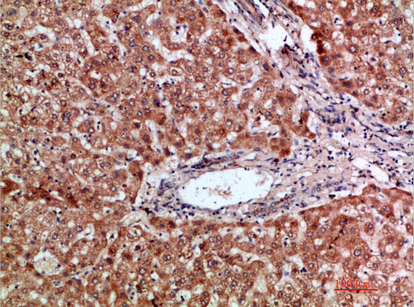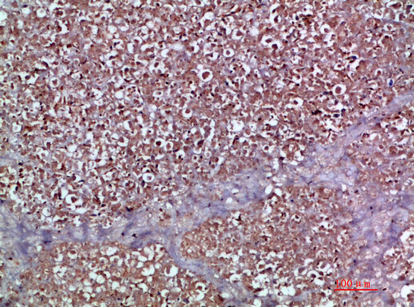MIP-3α Polyclonal Antibody
- Catalog No.:YT5955
- Applications:IHC;IF;ELISA
- Reactivity:Human;Mouse
- Target:
- MIP-3α
- Fields:
- >>Cytokine-cytokine receptor interaction;>>Viral protein interaction with cytokine and cytokine receptor;>>Chemokine signaling pathway;>>IL-17 signaling pathway;>>TNF signaling pathway;>>Rheumatoid arthritis
- Gene Name:
- CCL20 LARC MIP3A SCYA20
- Protein Name:
- C-C motif chemokine 20 (Beta-chemokine exodus-1) (CC chemokine LARC) (Liver and activation-regulated chemokine) (Macrophage inflammatory protein 3 alpha) (MIP-3-alpha) (Small-inducible cytokine A20) [
- Human Gene Id:
- 6364
- Human Swiss Prot No:
- P78556
- Mouse Gene Id:
- 20297
- Mouse Swiss Prot No:
- O89093
- Immunogen:
- Synthetic peptide from human protein at AA range: 31-80
- Specificity:
- The antibody detects endogenous MIP-3α
- Formulation:
- Liquid in PBS containing 50% glycerol, 0.5% BSA and 0.02% sodium azide.
- Source:
- Polyclonal, Rabbit,IgG
- Dilution:
- IHC 1:50-200, ELISA 1:10000-20000. IF 1:50-200
- Purification:
- The antibody was affinity-purified from rabbit antiserum by affinity-chromatography using epitope-specific immunogen.
- Concentration:
- 1 mg/ml
- Storage Stability:
- -15°C to -25°C/1 year(Do not lower than -25°C)
- Other Name:
- C-C motif chemokine 20 (Beta-chemokine exodus-1;CC chemokine LARC;Liver and activation-regulated chemokine;Macrophage inflammatory protein 3 alpha;MIP-3-alpha;Small-inducible cytokine A20) [Cleaved into: CCL20(1-67);CCL20(1-64);CCL20(2-70)]
- Background:
- This antimicrobial gene belongs to the subfamily of small cytokine CC genes. Cytokines are a family of secreted proteins involved in immunoregulatory and inflammatory processes. The CC cytokines are proteins characterized by two adjacent cysteines. The protein encoded by this gene displays chemotactic activity for lymphocytes and can repress proliferation of myeloid progenitors. Two transcript variants encoding different isoforms have been found for this gene. [provided by RefSeq, Sep 2014],
- Function:
- function:Chemotactic factor that attracts lymphocytes and, slightly, neutrophils, but not monocytes. Inhibits proliferation of myeloid progenitors in colony formation assays. May be involved in formation and function of the mucosal lymphoid tissues by attracting lymphocytes and dendritic cells towards epithelial cells. C-terminal processed forms have been shown to be equally chemotactically active for leukocytes. Possesses antibacterial activity E.coli ATCC 25922 and S.aureus ATCC 29213.,induction:By lipopolysaccharide (LPS), tumor necrosis factor and interferon gamma. Induced by phorbol myristate acetate (PMA) in U937 cell line and bowes melanoma. Repressed by IL-10.,online information:CCL20 entry,PTM:C-terminal processed forms which lack 1, 3 or 6 amino acids are produced by proteolytic cleavage after secretion from peripheral blood monocytes.,similarity:Belongs to the intercrine beta
- Subcellular Location:
- Secreted .
- Expression:
- Expressed in the seminal plasma, endometrial fluid and follicular fluid (at protein level). Expressed predominantly in the liver, lymph nodes, appendix, peripheral blood lymphocytes, and fetal lung. Low levels seen in thymus, prostate, testis, small intestine and colon.
- June 19-2018
- WESTERN IMMUNOBLOTTING PROTOCOL
- June 19-2018
- IMMUNOHISTOCHEMISTRY-PARAFFIN PROTOCOL
- June 19-2018
- IMMUNOFLUORESCENCE PROTOCOL
- September 08-2020
- FLOW-CYTOMEYRT-PROTOCOL
- May 20-2022
- Cell-Based ELISA│解您多样本WB检测之困扰
- July 13-2018
- CELL-BASED-ELISA-PROTOCOL-FOR-ACETYL-PROTEIN
- July 13-2018
- CELL-BASED-ELISA-PROTOCOL-FOR-PHOSPHO-PROTEIN
- July 13-2018
- Antibody-FAQs
- Products Images

- Immunohistochemical analysis of paraffin-embedded human-liver, antibody was diluted at 1:200

- Immunohistochemical analysis of paraffin-embedded human-pancreas, antibody was diluted at 1:200



